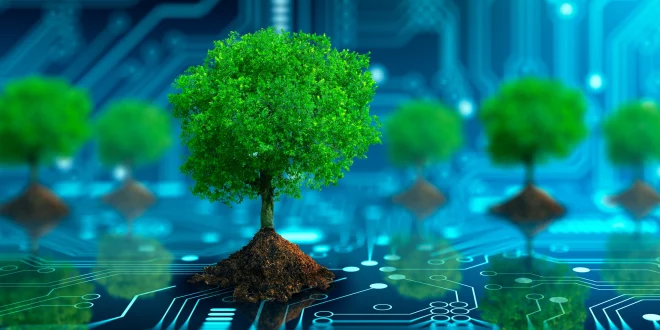In recent years, there has been a growing concern about the environmental impact of content creation, particularly in the digital age where information is constantly being produced and consumed. As businesses and individuals strive to make their online presence felt, it is crucial to address the environmental consequences of content creation. In this blog, we delve into the world of sustainable content creation and explore how technological innovations are paving the way for a greener future in the digital realm.
Understanding the Environmental Footprint of Content Creation
Content creation involves various processes, from ideation and research to writing, design, and distribution. Each step in this content lifecycle contributes to its environmental footprint. Factors such as energy consumption, carbon emissions, paper usage, and electronic waste play a significant role in this regard. Understanding the impact of these activities is the first step towards sustainable content creation.
Research shows that the carbon emissions from digital content creation are substantial, and they continue to rise as internet usage grows. In 2020 alone, the internet produced approximately 3.7% of global greenhouse gas emissions, and it is projected to double by 2025. This alarming statistic highlights the urgency to adopt eco-friendly practices in content creation.
The Role of Technology in Sustainable Content Creation
Fortunately, technology is not only contributing to environmental issues but also providing solutions to mitigate them. Tech innovations are empowering content creators and businesses to adopt eco-conscious practices without compromising their efficiency and productivity. Let’s explore some of the remarkable advancements that are revolutionizing sustainable content creation:
Cloud Computing and Virtualization
Cloud computing and virtualization are transforming the way content is stored, processed, and accessed. By shifting data centers and servers to cloud-based platforms, businesses can significantly reduce their energy consumption and carbon footprint. Cloud providers can optimize server utilization, leading to more efficient resource allocation and decreased power usage.
Renewable Energy Integration
Tech companies are increasingly embracing renewable energy sources to power their operations. Solar, wind, and hydroelectric energy are becoming key components of sustainable content creation strategies. By transitioning to renewable energy, businesses can ensure that their digital infrastructure operates with a smaller environmental impact.
AI-Powered Content Optimization
Artificial Intelligence (AI) is making content creation smarter and more efficient. AI algorithms can analyze data to understand what type of content resonates with audiences, thereby reducing the need for trial-and-error approaches. This optimization process helps in creating content that aligns with audience preferences and reduces unnecessary content production.
Virtual Collaboration and Remote Work
The rise of virtual collaboration tools and remote work practices has led to a decrease in the need for physical office spaces. This shift translates to reduced commute-related emissions and less energy consumption in office buildings. Remote work also promotes a healthier work-life balance, resulting in happier and more productive employees.
Sustainable Design and Packaging
Content creation involves not only digital assets but also physical products such as marketing materials and merchandise. Embracing sustainable design principles and eco-friendly packaging options can significantly minimize the environmental impact of physical content-related items.
Implementing Sustainable Content Strategies
As technology provides the means, it is essential for businesses and content creators to take proactive steps in implementing sustainable content strategies. Here are some practical tips to reduce your environmental footprint while maintaining the quality of your content:
Conduct a Content Audit
Start by assessing your existing content and identifying areas where improvements can be made. Remove outdated and low-performing content to streamline your digital footprint and reduce unnecessary server load.
Optimize Content for SEO and Relevance
Creating high-quality content that meets user intent is essential for SEO and reducing environmental impact. Target relevant keywords and focus on creating evergreen content that remains valuable over time, reducing the need for frequent updates.
Embrace Minimalism in Design
Simplicity not only enhances user experience but also reduces the digital file size, which can positively impact loading times and energy consumption. Embrace minimalist design principles in your content visuals and website layout.
Leverage Data Analytics
Data analytics can provide valuable insights into your content performance, allowing you to optimize content production and distribution strategies. By understanding what content resonates with your audience, you can create more impactful and efficient content.
Use Sustainable Hosting Solutions
Opt for hosting providers that prioritize renewable energy and have energy-efficient data centers. Green hosting options ensure your digital infrastructure aligns with your sustainability goals.
Commonly Asked Questions
Q1. What are the benefits of sustainable content creation?
Sustainable content creation not only reduces the environmental impact but also enhances brand reputation. By adopting eco-friendly practices, businesses can attract environmentally conscious audiences and foster customer loyalty.
Q2. How can AI improve content creation sustainability?
AI can analyze vast amounts of data to optimize content production and distribution, reducing wasteful content creation and reaching the target audience more effectively.
Q3. What role does renewable energy play in sustainable content creation?
By using renewable energy to power data centers and digital infrastructure, content creators can significantly reduce their carbon emissions and support a greener future.
Q4. How does remote work contribute to sustainable content creation?
Remote work reduces commute-related emissions and energy consumption in office spaces, leading to a more sustainable work environment.
Q5. How can businesses transition to sustainable content creation practices?
Businesses can start by conducting content audits, optimizing content for relevance and SEO, embracing minimalist design, leveraging data analytics, and choosing sustainable hosting solutions.
Final Words
Sustainable content creation is no longer an option but a necessity in today’s environmentally conscious world. By harnessing the power of technology and embracing eco-friendly practices, content creators and businesses can significantly reduce their environmental footprints without compromising their goals. It is crucial to take proactive steps towards sustainable content creation to ensure a greener future for generations to come.
 webfily
webfily


